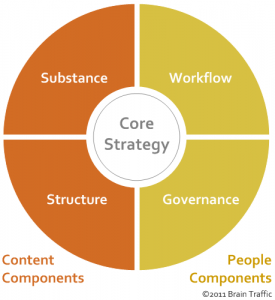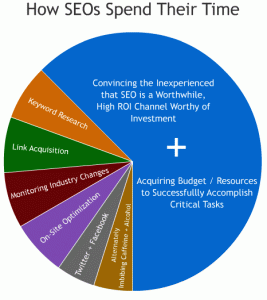After reading numerous articles about SEO and Content Strategy, one point seems to overlap and is mentioned often – which one – SEO or Content Strategy – is more important? The two seem to be participants of a soccer game. There are fans of both, and the rivalry is palpitating. The ball is kicked back and forth. Are SEO and Content Strategy friendly competitors or fierce adversaries?
First, I’ll introduce the two teams.
The first team is Content Strategy. It may be the slow and steady team but don’t overlook its tenacity. Content Strategy’s method is to communicate to the viewer the purpose and tone of the site. This is accomplished through accessible and intuitive user interface with emphasis on the placement of the words, data, and images on the site. Its strategy focuses on the game’s plays meticulously constructed before the match, before the action takes place.
Furthermore, Content Strategy is the development, then the management, of the planned content. This is the reason consumers come to web sites – to view what is for sale, to learn about a particular interest, to see what their competition is doing. The more exact and well-planned content – the better the site, the longer the consumer will stay on the site, and thus more revenue for the company. A pretty solid contender.
Below is an infographic detailing Content’s game day master plan. The graphic was sourced from blog.braintraffic.com blog, titled “How Nonprofits Can Profit from Content Strategy,†published by Teresa Gemelke, February 9, 2012.

Next comes opposing team SEO. SEO is the powerful use of research, search engine prowess, and ingenuity to capture the search engine spiders in their own web. A web site that utilizes exceptional SEO will often be placed in the top ten searches on Google. This is a marketing boon for a company’s presence on the web. It is priceless. SEO is fast, productive, energetic and has that golden glow.
Below is an infographic detailing SEO’s game day plays. The graphic was sourced from seomoz.org blog, titled “4 Essential SEO Infographics,†published and designed by Rand Fishkin, August 10, 2009.

So let the games begin!
During the first half of the match, SEO runs out and mesmerizes the fans. Content Strategy holds firm yet seems latent. Following is a reenactment of the first half’s power plays displayed on the cover of a magazine.
In a recent issue of a popular health and fitness magazine, I stopped at the short articles, read them quickly, and then looked for the rest of the content, which was not to be found. I flipped to the next page, patiently waiting for some valuable content about how I could reduce my sugar intake by hypnosis – or the like – but only found other short articles. I was so mystified by this content that I flipped through the entire magazine searching for a real article. It wasn’t there.
The magazine editors grabbed my attention by placing tag lines on the front page which peaked my interest, but they fell flat with the content. It was marketing frenzy with no content, nothing to engage or peak my curiosity for the next issue.
The SEO part of the magazine was the tag line, the headers that proclaimed fast weight loss, better skin, the perfect calorie-free chocolate bar. The Content Strategy must have been geared to quick scan articles, but it loses readers who want some real, hearty content. Only those who want pictures and a maximum of 100 word articles might find this worthwhile; the readership is limited.
In review, SEO got me there, got me to buy the magazine. Content Strategy lost me, to never look at that magazine again (or possibly until I am duped by the tagline of miracle sleep aid for those who don’t have time to sleep). SEO scored. Content Strategy seemed to be sleeping on the field.
Halftime Results:    SEO – 1    Content Strategy – 0Â
On to the second half.
In the second half, Content Strategy has warmed up, awake and ready to defend. SEO still maintains energy. Who will prevail? The power plays are detailed with a Google keyword search.
After reading an article in the New York Times about the restoration of the Ghent Altarpiece completed in 1432 by Hubert and Jan van Eyck, I wanted to do a little more research on the topic. It was one of those moments where I wanted to expand my mind into realms other than CSS manipulations and HTML basics.
Now, I assume we all love Wikipedia, but, really, how veritable is the content? Wikipedia has SEO covered with multiple keyword mentions and multiple links within each page. It comes up first, always. I for one do not solely take its words to heart. I find it to be a good source of quick information but not for the serious researcher, which I was for that day…
On down with my Google search – keyword search specifically “Ghent Altarpiece†– I found multiple articles on the subject matter, forums discussing the paint techniques and juxtaposition of this figure next to that figure, and Museums’ curatorial notes on the subject of this single piece. Very few had the heft I was searching for. The ball was rolling towards the goal but no score. Content Strategy had a wall of defenders at the goal.
I needed bulk. I was searching for content. I considered running to the library but the internet is much more accessible. So I kept searching and found the site I was reaching for, through my relentless demand to find the content. As the viewer I was working with Content Strategy, and thereby Content stole the second half and managed to kick the ball in the goal.
Content Strategy’s defense prevented SEO’s offense from scoring, pushing SEO back time after time, and finally making the goal.  It was a well played game.
Final:    SEO – 1    Content Strategy – 1
Recap
The winner of the SEO vs. Content Strategy battle is a tie. It may have had a few questionable flags thrown in, but all in all, you can’t have one without the other. SEO is unquestionably the most popular and visible. It’s the offense. Content Strategy is the heart of the matter. It is the defense, strong and impenetrable.
Put SEO and Content Strategy on the same team and you will have a winner every time.